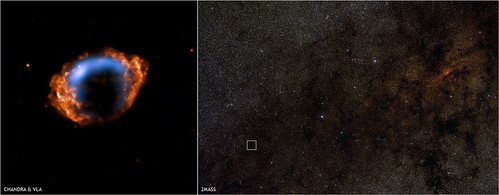Youngest Supernova Found

Very cool announcement from NASA this afternoon, uncovering the most recent supernova from 140 years ago:
"We can see some supernova explosions with optical telescopes across half of the universe, but when they’re in this murk we can miss them in our own cosmic backyard," said Stephen Reynolds of North Carolina State University in Raleigh, who led the Chandra study. "Fortunately, the expanding gas cloud from the explosion shines brightly in radio waves and X-rays for thousands of years. X-ray and radio telescopes can see through all that obscuration and show us what we’ve been missing."
Astronomers regularly observe supernovae in other galaxies like ours. Based on those observations, researchers estimate about three explode every century in the Milky Way.
"If the supernova rate estimates are correct, there should be the remnants of about 10 supernova explosions that are younger than Cassiopeia A," said David Green of the University of Cambridge in the United Kingdom, who led the Very Large Array study. "It’s great to finally track one of them down."
The tracking of this object began in 1985, when astronomers, led by Green, used the Very Large Array to identify the remnant of a supernova explosion near the center of our galaxy. Based on its small size, it was thought to have resulted from a supernova that exploded about 400 to 1000 years ago.
Twenty-two years later, Chandra observations revealed the remnant had expanded by a surprisingly large amount, about 16 percent, since 1985. This indicates the supernova remnant is much younger than previously thought.
That young age was confirmed in recent weeks when the Very Large Array made new radio observations. This comparison of data pinpoints the age of the remnant at 140 years – possibly less if it has been slowing down – making it the youngest on record in the Milky Way.
Besides being the record holder for youngest supernova, the object is of considerable interest for other reasons. The high expansion velocities and extreme particle energies that have been generated are unprecedented and should stimulate deeper studies of the object with Chandra and the Very Large Array.
"No other object in the galaxy has properties like this," Reynolds said. "This find is extremely important for learning more about how some stars explode and what happens in the aftermath."
Here’s an animation from the Chandra X-Ray Observatory:
In order to determine the age of G1.9+0.3, astronomers needed to track how quickly it is expanding. By comparing a radio image from 1985 to a Chandra image taken in 2007, scientists see the ring of debris expand. The expansion rate was confirmed with another radio observation with the VLA in 2008. The difference in size between these images gives clear evidence for expansion, allowing the age of the remnant and the time since the original supernova explosion (about 140 years) to be estimated.
